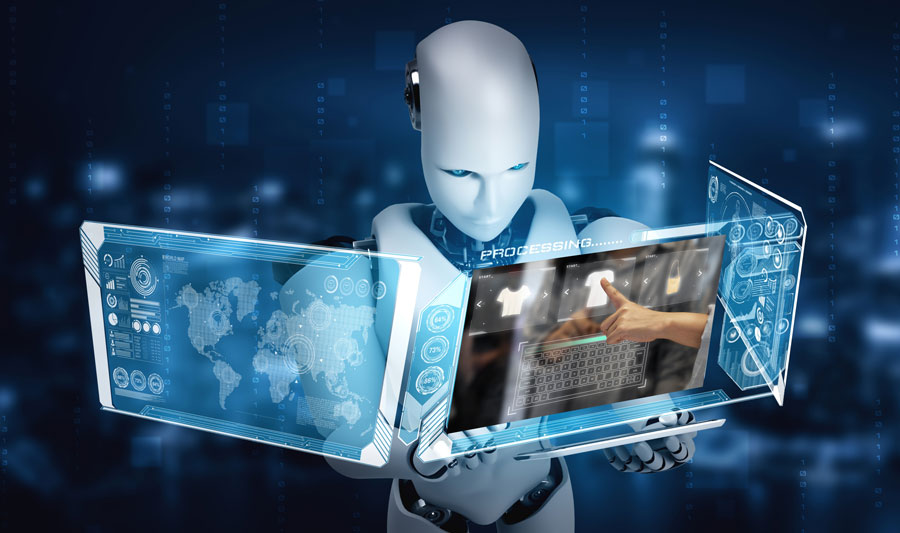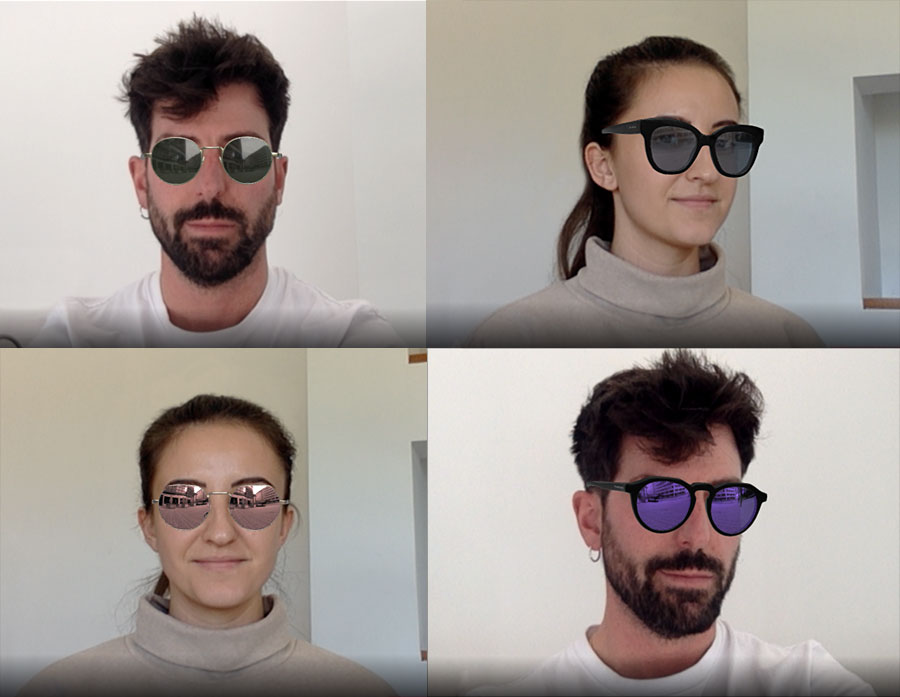Artificial intelligence (AI) has radically transformed the way businesses sell products. Thanks to advances in this technology, retailers can provide a more personalized, accurate, and satisfying shopping experience for their customers. One of the most exciting applications of AI in product sales is mixed reality, also known as augmented reality, which allows customers to view and try virtual products in real-time.

Our sunglasses company, Hawkers, has partnered with Amazon, one of the world’s largest e-commerce companies, to offer consumers the ability to virtually try on our sunglasses before making a purchase. Staying true to our constant innovation goal, we have created an app that allows customers to virtually try on our sunglasses using mixed reality. The app uses the user’s phone camera and facial tracking technology to place the sunglasses virtually on their face in real-time.
Customers can try on the sunglasses and see how they look from different angles, moving their heads to check if they really like them from various perspectives. This technology is an excellent way for customers to try out our different models and colors of sunglasses before purchasing, bringing the experience closer to that of trying them in a physical store but with the convenience of doing it online.

This initiative is yet another example of how technology is revolutionizing the e-commerce sector, allowing consumers to have a much more satisfying and personalized shopping experience. The virtual try-on service is an example of how technology can help businesses improve their sales and foster customer loyalty.
Additionally, this collaboration between Amazon and Hawkers demonstrates the importance of strategic partnerships between companies to achieve common goals and leverage their strengths. Amazon, with its vast customer base and e-commerce platform, and Hawkers, with its expertise in designing and producing sunglasses, have combined their strengths to offer consumers a unique and differentiated shopping experience.
According to Marketing Directo, this service is known as Virtual Try-On or VTO, and it is available at amazon.co.uk/virtualtryon . In the following video, you can see how the application works.
The use of augmented reality, like Hawkers’ Virtual Try-On, and virtual reality solutions provide the following advantages for eCommerce:
- Immersive shopping experience
An immersive shopping experience is offered to customers. Augmented reality allows customers to see products in their real-world environment, while VR lets them explore products in a virtual environment. Both technologies enable customers to see products in detail and better evaluate their size, texture, and other attributes.
- Greater customer interaction
It allows greater customer interaction with the products. Customers can interact with products, rotate them, view them from different angles, and explore customization options. This interaction increases customer engagement and can lead to higher sales conversion.
- Reduced returns
By allowing customers to try products in virtual environments before purchasing, returns due to poor choices are reduced. With VTO and VR, customers can experience products more realistically, reducing returns due to discrepancies between expectations and reality.
- Competitive differentiation
Implementing it in our eCommerce helps us stand out from our competitors. By offering an immersive and highly interactive shopping experience, companies can differentiate themselves from the rest and create a positive image in customers’ minds.
- Increased customer satisfaction
Services like VTO can also improve customer satisfaction. By offering a unique and exciting shopping experience, companies can increase customer satisfaction and encourage long-term loyalty.
- Lower marketing costs
By offering an immersive shopping experience, companies can reduce the need for expensive advertising campaigns and focus on the customer experience instead, thus reducing marketing costs.
- Greater supply chain efficiency
By allowing customers to see products in detail before purchasing, companies can reduce the number of returns and improve supply chain efficiency. - Product experimentation
Both augmented reality and virtual reality allow companies to offer customers the possibility to customize products to their liking, with the level of customization set by the company. Customers can request customizations that make their product unique and perfectly suited to their preferences, creating a unique value proposition. - Improved customer communication
By allowing customers to interact with products in a virtual or augmented environment, companies can gather valuable information about customer preferences and needs.
Other solutions
In addition to virtual and augmented reality, artificial intelligence offers many other applications to enhance eCommerce businesses. In our 2020 article, «6 Uses of Artificial Intelligence to Improve E-commerce,» we introduced the most interesting ones at that time. However, in the past two years, this technology has developed exponentially, not only adapting and improving the solutions we presented but also introducing several new ones. Here are eight that we find interesting at this moment and will likely cover in more detail in future articles:
- Personalized shopping experience
Personalizing the shopping experience is one of AI’s greatest benefits in eCommerce. Through a system called Machine Learning (ML), AI learns without prior programming. By analyzing customer shopping behavior, including product searches and past purchases, AI can provide personalized product recommendations and suggestions that increase the likelihood of a sale. For example, Amazon uses AI to recommend related products based on the customer’s purchase history and previous searches. Another example is Netflix, which recommends movies and series based on the user’s interaction with each category and title. Google also uses it to display relevant ads based on our interests, maximizing its revenue. - Inventory optimization
AI is already being used to predict product demand and optimize inventory in real-time. This helps reduce storage costs and increase operational efficiency. For example, the online clothing store ASOS uses AI to predict product demand and manage inventory in real-time, reducing storage costs and improving supply chain efficiency. Samsung is another company using AI to predict future demand and adjust its inventory and sales strategy accordingly. - Chatbots and customer service
AI-powered chatbots can answer questions and help customers in real-time, improving customer satisfaction and reducing customer service costs. H&M, for instance, uses AI chatbots to assist customers with frequently asked questions and direct them to the correct page on the website. The arrival of AI-based chat systems like OpenAI’s ChatGPT has brought a revolutionary leap in this technology. Chatbots can «create» coherent, unscripted responses based on vast databases of information. The result is that customers can «converse» with them, and the responses are often more comprehensive and relevant than what a human operator could provide, with the advantage of 24/7 availability. - Price and competition analysis
AI is also being used to analyze competitor prices and market demand, helping companies adjust their product prices to be more competitive and increase sales. For example, American consumer electronics retailer Best Buy uses AI to adjust its online prices in real-time, allowing it to be more competitive in the market. - Ad performance optimization
With AI, we can analyze the performance of advertising campaigns and adjust them in real-time to improve return on investment. For example, Facebook already uses AI to optimize its customers’ ads, adjusting budgets, content, segmentation, and targeting to achieve the best performance. - Security and fraud detection
Cybercrime continues to grow. AI is an efficient tool used to detect fraudulent behavior patterns and protect customer data. This improves customer trust and reduces the risk of fraud. PayPal uses AI to detect fraudulent behavior patterns and prevent unauthorized transactions from occurring in customer accounts. The economic and reputational impact of cyberattacks is significant, making this a field with a bright future. - Product search optimization
Improving product search results helps customers find products more easily and increases sales. AI is becoming increasingly efficient in this task as well. Zara, for example, uses AI in its search engine, and since its implementation, search results have become more relevant, which, given internet users’ preference for immediacy, has significantly increased its conversion rate. - Logistics optimization
Many companies are using AI to optimize shipping and delivery logistics, reducing costs and improving efficiency. For example, the online fresh food retailer FreshDirect uses AI to optimize delivery scheduling and routes, reducing delivery time on the road and the associated labor and fuel consumption.
In summary, artificial intelligence is revolutionizing the way companies sell products. Mixed reality, data analytics, personalization, and fraud detection are just some of the AI applications in product sales. AI’s ability to enhance the shopping experience and increase sales makes it a valuable tool for any retailer looking to improve their business. There’s no doubt that AI will continue to evolve exponentially, improving both efficiency and customer experience in eCommerce. Can you afford to be left out?